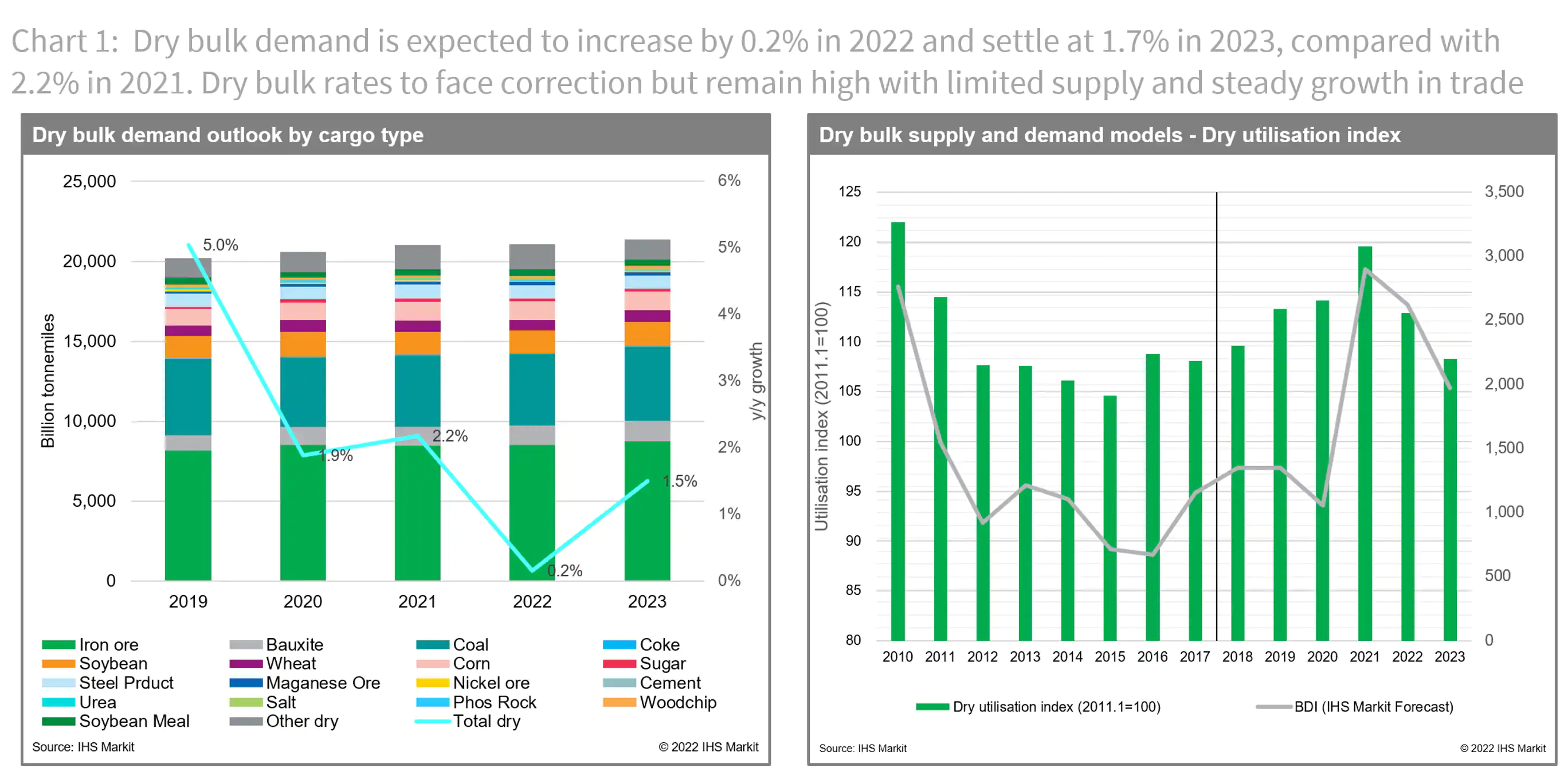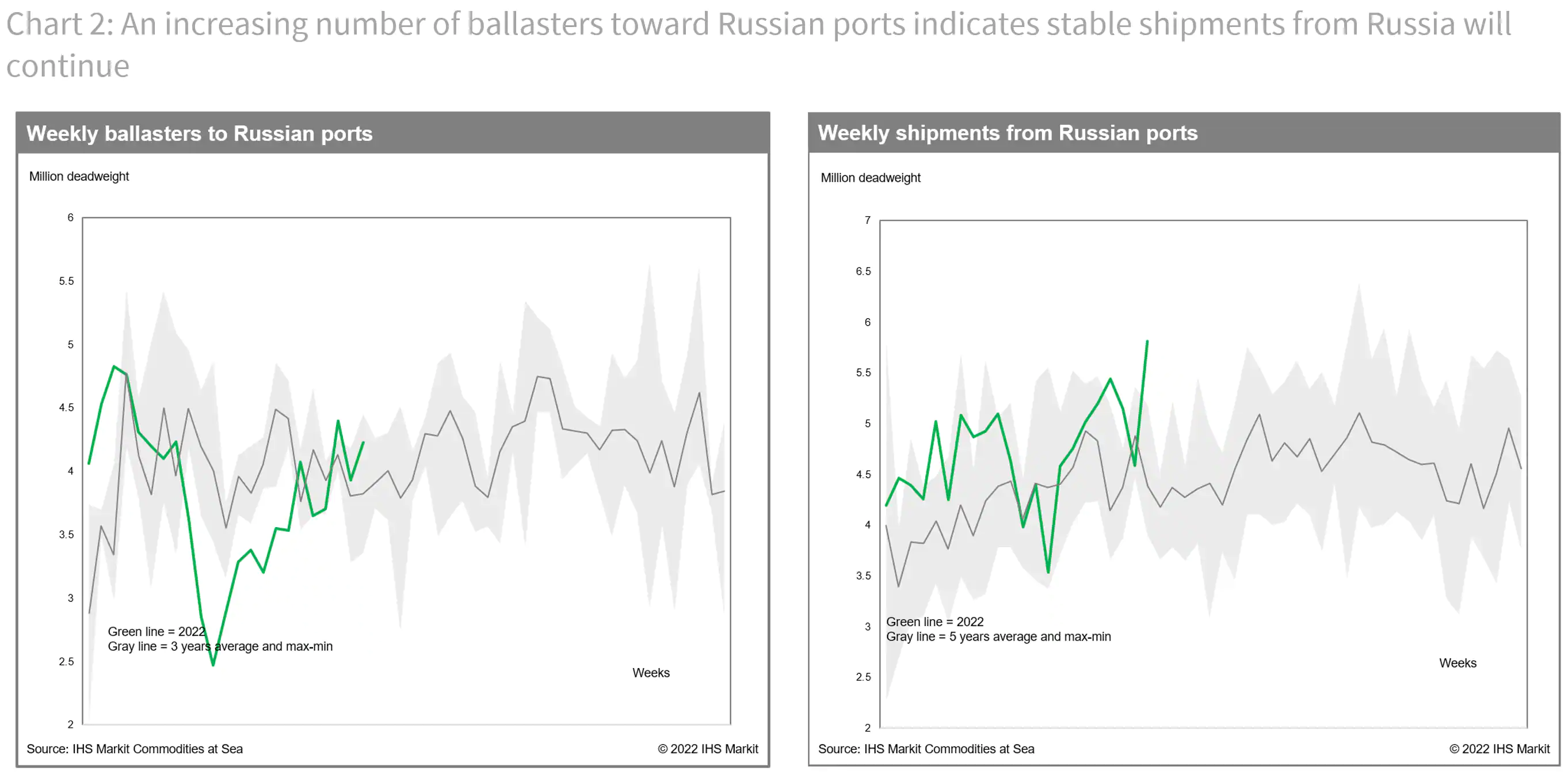Shipping market outlook – Container vs Dry bulk : Q2 2022
update
Download the complimentary summary reports
English | Chinese | Japanese | Korean
As of writing (30 May 2022), Capesize rates dropped
significantly and negatively impacted sentiments of smaller
vessels. With an unexpected drop in freight rates, many
long-position players either in FFA or physical have no options but
to cover their position in the FFA market or secure cargo to
near-term position, triggering more downside pressure in the
short-term. However, regardless of the short-term sentiment-FFA
driven rates movement, we believe that the fundamental supply and
demand balance will eventually determine the market.
S&P Global Market Intelligence forecasts dry bulk rates to
remain stable in the coming years with limited supply and stable
growth in trade—more bullish in the near-term and bearish for
medium-term. Dry bulk demand growth is expected to decrease to 0.2%
in 2022 and settle at 1.7% in 2023, compared with 2.2% in 2021,
while dry bulk fleet growth will slow to 2.8% in 2022, 2.2% in
2023, and 2.4% in 2024, compared with 3.4% in 2021.

With Commodities at Sea from S&P
Global Market Intelligence, we continue to witness the strength in
Russian cargo shipments; increasing number of ballasters towards
Russian ports indicate the stable shipments out of Russia will
continue before several sanctions, including the European import
ban, which starts in the third quarter. Furthermore, European
demand for Australian coal to prepare for the consequences of
Russian coal import ban, as well as stable minor bulk shipments,
including steel out of the Pacific Basin, is expected to support
backhaul routes in the near-term.

The backhaul remains one of the strongest routes and we expect
it to continue with strength in the container market and
replacement demand for Ukrainian and Russian cargo. We have
consistently argued that as long as container rates remain high
enough to capture part of general bulkers and open hatch cargo
vessels in the container sector commercially, geared bulker rates
are expected to be supported, specifically for backhaul routes.
General cargo (breakbulk) vessels that have shared similar terminal
and cargo with geared bulkers (Supramax and Handysize) have shifted
to the container-linked market because of extremely high freight
rates for container ships this year; container cargo has been
spilling over to general cargo ships (breakbulk/MPV/HL), while
minor bulk cargo usually carried by container or general cargo
vessels have shifted to geared bulkers. Furthermore, with general
cargo ships mostly picking up container-related cargoes, there has
been much less competition from general cargo vessels for
Supramax/Handysize minor bulk routes. These higher demand and
lesser supply balance have boosted geared bulkers’ backhaul rates
even higher.
However, we remain cautious towards the end of the year as we
have observed several downside risks from the later part of the
third quarter of 2022 compared with the same period in 2021.
Specifically, we are tracking the mainland Chinese coal market very
carefully since stronger domestic coal production in mainland China
may eventually limit mainland Chinese coal import demand, which was
one of the main drivers for the strength in the third quarter of
2021. Furthermore, we do not expect extremely high congestion again
in the coming quarters as the result of the easing of COVID-19
restriction. Also, the softening of the container trade growth,
along with high inflation, will be a major risk towards the end of
the year when the third quarter peak season is over.

See the list of risk factors below.
• Softening container market with changing consumer pattern, as
well as weaker purchasing power that will impact smaller segments’
minor bulk demand
• Higher efficiency or productivity of vessels with reduced
congestion and higher speed
• Lower Russian coal demand after the European and Japanese coal
import ban, stronger domestic coal production in mainland
China
• Limited wheat export volume during the Black Sea grain season
DOWNLOAD THE FULL REPORT FOR DEEPER
ANALYSIS COVERING STEEL, IRON ORE, COAL, GRAIN, AND FREIGHT
In this context, S&P Global Market Intelligence Freight Rate Forecast models
predicts Baltic Dry Index (BDI) to increase in the early third
quarter compared with the second quarter with the restocking demand
from Europe before the Russian coal imports ban and seasonal
recovery in shipments as well as continued strength in commodity
prices. However, the dry bulk earning is expected to fall about
20-30% on the year to average about 2,500 – 3,000 points in second
half 2022 with several downside risks, including the major
supply-side impact from the Ukraine-Russia conflict and demand-side
impact from weaker mainland Chinese economy and stronger domestic
coal production and softening container market.
Specifically on the container market impact, we have
consistently argued that as long as container freight rates remain
high enough to capture part of general cargo vessels (multipurpose)
and open hatch cargo vessels share in the container sector
commercially, small geared bulker rates are expected to be
supported, specifically for the backhaul routes. That is why our
major assumption for dry bulk demand and supply has been heavily
linked with the container market outlook.
Currently, we assume container freight rates will also face
correction and decline by 20-30% to average about $6,000-7,000 per
box (FEU) in the second half of 2022 from an average of about
$9,000-10,000 per box (FEU) over the same period last year. The
softening of container trade growth in response to high inflation
rate, endemic consumer pattern, and supply side pressure with heavy
investment in newbuildings, as well as reduced congestion with the
easing of COVID-19 restrictions will be major downside risks in the
second half of the year, specifically after the third-quarter peak
season is over.
Another lockdown in mainland China, slower than expected
economic growth with continued high inflation, and a lack of
stimulus would be a major downside risk, while continued strength
in container freight with high congestion and limited
infrastructure, as well as lower-than-expected domestic coal
production in mainland China and earlier-than-expected reopening of
Ukrainian sea ports would be a major upside risk in our
forecast.
For more insight subscribe to our
complimentary commodity analytics newsletter
This article was published by S&P Global Market Intelligence and not by S&P Global Ratings, which is a separately managed division of S&P Global.

